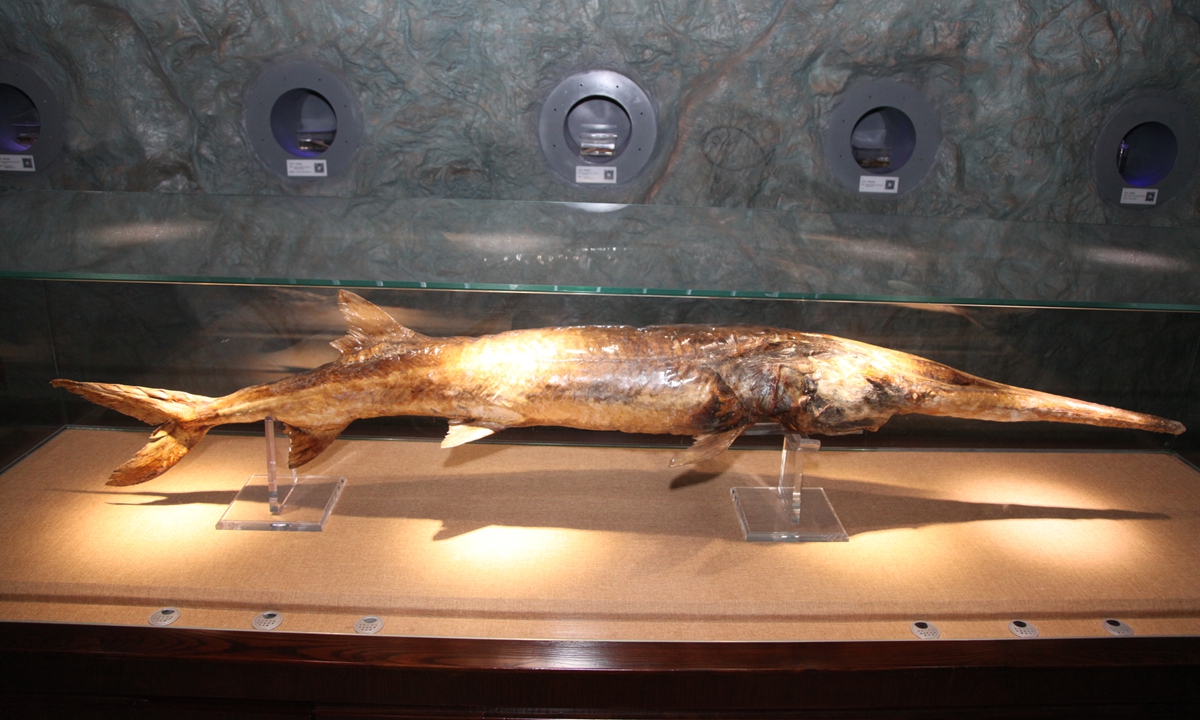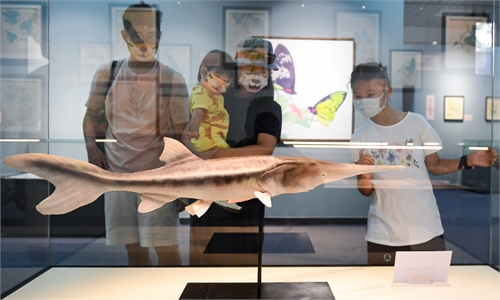Yangtze fishing ban helps avoid further losses as public laments Chinese paddlefish extinction

Specimen of a Chinese paddlefish, Photo: VCG
As the public laments the extinction of the Chinese paddlefish, a flagship species in the Yangtze River, and calls for stronger protection of existing unique aquatic species, experts noted that cautious hydraulic engineering, artificial breeding and whole-watershed protection are needed to rescue fish that face critical danger.
A 10-year fishing ban, better bio-protection technologies and tighter approval procedures for hydropower projects can hopefully ease the huge pressure those species face and prevent them from meeting the same fate as the Chinese paddlefish, they said.
The Chinese paddlefish was announced as being extinct by the International Union for Conservation of Nature (IUCN) on Thursday in its renewed red list of threatened species.
The Yangtze sturgeon was announced as being "extinct in the wild" and the Chinese sturgeon was "critically endangered."
A study published in 2019 by a Chinese conservation team had already declared extinction for the Chinese paddlefish as no live ones had been seen since 2003.
The Chinese paddlefish is one of the largest freshwater fish in the world, and it can grow up to seven meters. It has lived on Earth since 125 million years ago and is therefore dubbed a "living fossil."
As netizens lamented the species on social media, some suspected its extinction was related to the giant Three Gorges Dam, saying that hydraulic projects disturbed their reproduction migration.
But considering that the paddlefish was endangered as early as the late 1990s, the Gezhouba Dam, which started to be built in 1981 and went into use in 1988, may have played a bigger role, according to observers.
Wei Qiwei, co-author of the 2019 study and an expert on sturgeon protection, told the Global Times that in addition to the disturbance to reproduction, overfishing made food for the paddlefish scarce, while burgeoning river traffic and sand mining either directly killed the fish or destroyed the riverbed where paddlefish rest and search for food.
Ma Jun, founder and director of the Beijing-based Institute of Public and Environmental Affairs, told the Global Times that the Three Gorges Dam has had less impact on fish migration than the Gezhouba, which on the downstream had already cut the reproduction route between estuaries and the middle reaches of the river.
The "critically endangered" Chinese sturgeon, which migrates from estuaries to the upper and middle reaches of the Yangtze, has to turn to an artificial spawning ground on the downstream of the Gezhouba.
Wei's team has been tracking the situation of the sturgeon and no natural reproduction of the species has been detected since 2017, as not enough of the fish can make it from the sea back to the middle reaches due to marine degradation, and the single artificial spawning ground is incomparable to the natural one above the dam.
The Chinese paddlefish became extinct before it could be artificially bred, but large number of artificially bred Chinese sturgeon are released to maintain the species' population every year.
However, Ma warned that the drop of the wild population and failure of natural reproduction will lead to a dim future for the sturgeon.
The expert said that the impact of the Three Gorges project and many other projects is that the reservoirs inundate shoals where fish reproduce and search for food.
Yet there are also positive factors. The 10-year fishing ban that started in 2020 will enrich the sturgeons' food sources while better handling pollution, which will also improve their living environment, experts said.
No more large development projects will be launched along the Yangtze River, the top leader announced in 2016, which pointed to a direction for hydraulic exploration on small rivers.
The Yangtze River Protection Law, China's first watershed-specific law, which took effect in March 2021, also enabled better coordination among provinces and broader vision of the protection work, according to experts.
Ma recalled a debate among different cities over the "Xiaonanguo" hydraulic project on an upstream section of the Yangtze River in the 2010s, and the project was ultimately halted by central authorities. Some small projects were even demolished, allowing the natural riverbed to return and local species to prosper.
He said that cautious building of projects, and careful design and operation to retain passages for aquatic species, are among the methods crucial for the protection of the Yangtze species at the brink of extinction.
Wei stressed that clear delegation of responsibility and funding are required to make protection efforts more effective.
The decline of wild species is a global trend and aquatic species are in a more dangerous situation than land species. According to the Intergovernmental Science-Policy Platform on Biodiversity and Ecosystem Services under the UN, land species' population dropped around 40 percent while the declines for freshwater and marine species were 84 and 35 percent.
The sturgeon's situation is an epitome — 18 out of 26 sturgeons are at the brink of extinction, according to the IUCN.

